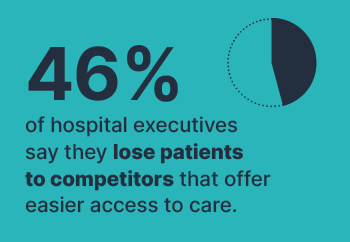eVisitor expands on his recent article in Healthcare Business Today.
The term “digital front door’ has become the latest buzzword in healthcare IT. It’s been a central focus at global industry conferences such as HIMSS and the featured topic of countless industry webinars, articles, and marketing campaigns over the past few years.
As I wrote in a recent Healthcare Business Today article, you’d think I’d be ecstatic about the term’s newfound notoriety. While I’m thrilled the concept is gaining traction and adoption, I’m also a bit concerned by the limited breadth and scope sometimes tied to the phrase.
Establishing a digital connection between providers and patients is an essential component to improving patient experience, provider efficiency, and health outcomes. However, this entry point must extend beyond the front-end of the patient encounter. Furthermore, digitization shouldn’t be positioned as the end-all-be-all of patient interaction. Instead, digital technology must complement, extend, optimize, and facilitate traditional methods of care to ensure positive encounters throughout the continuum of care and prevent patient leakage.
Bridging the digital divide
According to McKinsey consumer and physician surveys, 60% of patients say virtual health is more convenient than in-person care. However, only 36% of providers find virtual care more convenient for themselves.
A 2020 study by Accenture also showed that 26% of Americans said they’d be willing to change their health provider in exchange for a better digital experience. These statistics validate the importance of providing strong digital healthcare experiences.
It’s also important to remember that some patients just don’t prefer virtual encounters. In fact, a significant percentage of at-risk populations remain technology averse. According to a University of Michigan Poll on Healthy Aging, older adults (age 50-80) expressed several concerns tied to digital technologies such as telehealth. For example, 68% of respondents feared the quality of care wouldn’t be as good as a face-to-face visit, 49% had privacy concerns, and another 49% thought they’d have difficulty using the technology.
Preventing patient leakage requires flexible touchpoints
These contrasting statistics illustrate the importance of facilitating interaction with the health system on the patient’s terms. Failure to do so can lead a patient to seek care elsewhere. According to a report from ABOUT, hospital executives say the primary cause of patient leakage is competitors that make it easier for patients to gain access to services (referenced by more than 46% of hospital respondents).
However, ease of access doesn’t just mean offering a digital front door. It requires a balance of new and traditional approaches. The more efficient new technology is at accelerating traditional processes, the better a health system is positioned to engage and retain patients at both ends of the digital spectrum.
To reduce patient leakage, I encourage providers to maintain connectivity and support regardless of where and how patients enter your environment—whether that’s a phone call, web search, or visit to the ER. Digital doorways, particularly those at the front-end, should facilitate and accelerate a provider’s ability to assess patients and navigate them to the most appropriate point of care, be it an urgent care center, virtual visit, or online chat with a provider.
Health providers should leverage digital and virtual tools to enable hybrid care delivery, providing customers with multiple touchpoints that appeal to convenience and preference while streamlining traditional care navigation.
In part 2 of this blog, I’ll provide a detailed look at how telehealth and other digital technologies can be effectively deployed to accelerate and enhance traditional processes such as triage, care navigation, and patient intervention and outreach. The end goal is to ensure the best care is delivered to patients at the right place and time.
Learn more
Read Dave's article in Healthcare Business Today and watch for part 2 of this blog next week!


